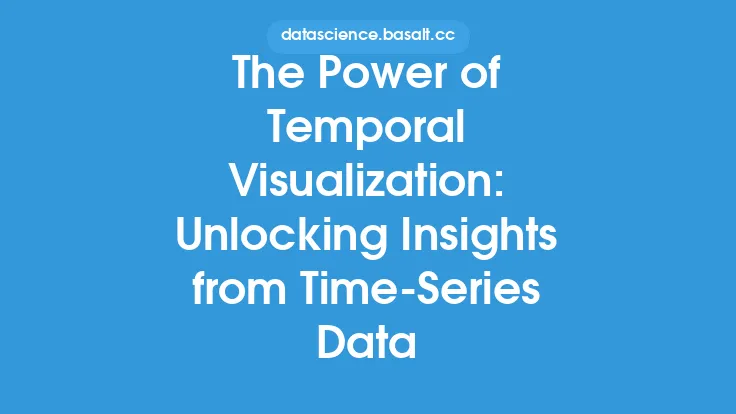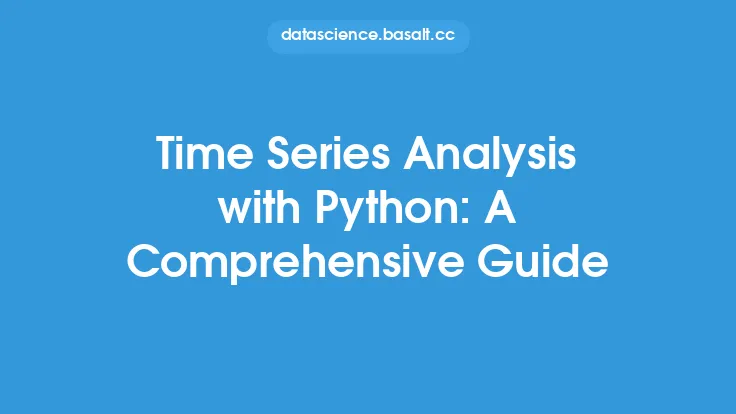Time series data is a sequence of data points measured at regular time intervals, and it is commonly used in various fields such as finance, weather forecasting, and traffic management. Anomaly detection in time series data is the process of identifying data points that are significantly different from the normal behavior of the data. These anomalies can be indicative of interesting patterns or events, such as a sudden increase in sales or a change in weather patterns.
Introduction to Time Series Anomaly Detection
Time series anomaly detection is a crucial task in many applications, as it can help to identify potential problems or opportunities. For example, in finance, anomaly detection can be used to identify unusual patterns in stock prices or trading volumes, which can be indicative of fraudulent activities or market trends. In weather forecasting, anomaly detection can be used to identify unusual weather patterns, such as a heatwave or a cold snap, which can have significant impacts on agriculture, transportation, and human health.
Characteristics of Time Series Data
Time series data has several characteristics that make it unique and challenging for anomaly detection. These characteristics include:
- Trend: Time series data can exhibit trends, which are long-term patterns of increase or decrease.
- Seasonality: Time series data can exhibit seasonality, which are regular fluctuations that occur at fixed intervals, such as daily, weekly, or yearly cycles.
- Autocorrelation: Time series data can exhibit autocorrelation, which is the correlation between data points at different time lags.
- Non-stationarity: Time series data can be non-stationary, which means that the distribution of the data changes over time.
Types of Anomalies in Time Series Data
There are several types of anomalies that can occur in time series data, including:
- Point anomalies: These are individual data points that are significantly different from the surrounding data points.
- Contextual anomalies: These are data points that are anomalous in a specific context, such as a sudden increase in sales during a holiday season.
- Collective anomalies: These are groups of data points that are anomalous together, such as a sequence of data points that exhibit a unusual pattern.
Techniques for Time Series Anomaly Detection
There are several techniques that can be used for time series anomaly detection, including:
- Statistical methods: These methods use statistical models, such as autoregressive integrated moving average (ARIMA) models, to identify anomalies.
- Machine learning methods: These methods use machine learning algorithms, such as neural networks and decision trees, to identify anomalies.
- Distance-based methods: These methods use distance metrics, such as Euclidean distance and dynamic time warping, to identify anomalies.
- Density-based methods: These methods use density estimation techniques, such as kernel density estimation, to identify anomalies.
Challenges in Time Series Anomaly Detection
Time series anomaly detection is a challenging task, and there are several challenges that must be addressed, including:
- Noise and missing values: Time series data can be noisy and contain missing values, which can make it difficult to identify anomalies.
- Non-stationarity: Time series data can be non-stationary, which means that the distribution of the data changes over time, making it challenging to identify anomalies.
- High dimensionality: Time series data can be high-dimensional, which means that there are many features or variables to consider, making it challenging to identify anomalies.
- Class imbalance: Time series data can be imbalanced, which means that there are many more normal data points than anomalous data points, making it challenging to train machine learning models.
Evaluation Metrics for Time Series Anomaly Detection
There are several evaluation metrics that can be used to evaluate the performance of time series anomaly detection models, including:
- Precision: This is the number of true positives (anomalies that are correctly identified) divided by the number of false positives (normal data points that are incorrectly identified as anomalies) plus true positives.
- Recall: This is the number of true positives divided by the number of false negatives (anomalies that are not identified) plus true positives.
- F1-score: This is the harmonic mean of precision and recall.
- Mean average precision (MAP): This is the average precision at each recall level.
Real-World Applications of Time Series Anomaly Detection
Time series anomaly detection has many real-world applications, including:
- Finance: Anomaly detection can be used to identify unusual patterns in stock prices or trading volumes, which can be indicative of fraudulent activities or market trends.
- Weather forecasting: Anomaly detection can be used to identify unusual weather patterns, such as a heatwave or a cold snap, which can have significant impacts on agriculture, transportation, and human health.
- Traffic management: Anomaly detection can be used to identify unusual traffic patterns, such as a traffic jam or a road closure, which can help to optimize traffic flow and reduce congestion.
- Healthcare: Anomaly detection can be used to identify unusual patterns in patient data, such as a sudden increase in heart rate or blood pressure, which can be indicative of a medical condition.





